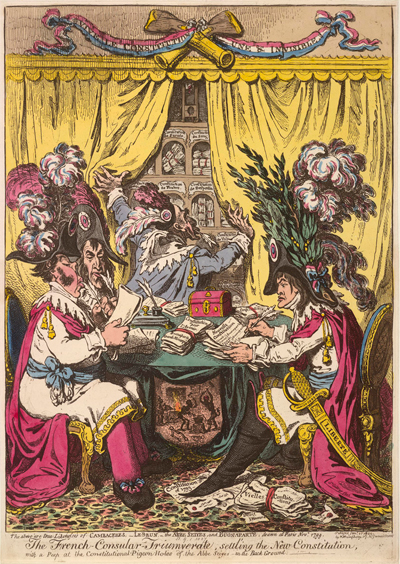The French Consular-Triumverate. . .
In this imagined scene, Napoleon, with his two newly-appointed Consuls, is shown writing a revised Constitution to replace the 1793 Constitution which had been effectually dissolved by his coup d'etat of the 9th of November 1799.* (Napoleon's foot treads upon a torn version of the Constitution of 1793. Next to that, also on the floor, are discarded old constitutions and the foundational "Droits l'Homme" [Rights of Man]).

© Trustees of the British Museum
He is being assisted (as he was in the plans for the coup itself) by the unscrupulous Abbé Sieyès (shown appropriately in the background) who thought he was using Napoleon as the "sword" for his own grasp at absolute power. Gillray's depiction of Sieyès recalls Edmund Burke's remark in his Letter to a Noble Lord (1796) that the wily Abbé, the ultimate survivor, had "pigeon-holes full of constitutions ready made, ticketed, sorted, and numbered; suited to every season and every fancy." Unfortunately, at the top of all of them, like the earlier initiatives of the Terror, the guillotine appears ominously.
Napoleon, however, has his own plans for the new Constitution which we can see on the paper before him where he is busily assigning his own name to every position to be filled. And if the direction of his thought was not already clear, the bound papers at the center of the print are inscribed: "Constitution pour l'Avenir [Constitution for the future]: Buonaparte Grande Monarque."
The papers in the hands of the other Consuls are, like the Consuls themselves, blanks: only there to provide the semblance of constitutional process. All of them wear the ceremonial robes of a member of the former Executive Directory. But Gillray has portrayed Napoleon armed with a huge sword (not usually necessary for a writing project or an executive meeting), which may suggest Buonaparte's burgeoning paranoia after being threatened and slightly injured during the coup. Gillray has also made Napoleon's feathered headdress impossibly large to suggest his outrageous pretensions. And the British Museum commentary is certainly correct in suggesting that the additional olive branches (complete with more than a half-dozen olives) interspersed with the feathers is probably meant to allude to Napoleon's 25 December peace offering to King George in which he famously presumed to address the King directly (as, in effect, one monarch to another) and asked (with a wonderfully Freudian projection of his own motives and values:)
Are there no means of coming to an understanding? How can the two most enlightened nations of Europe, powerful and strong beyond what their safety and independence require, sacrifice to ideas of vain greatness the benefits of commerce, internal prosperity, and the happiness of families? How is that they do not feel that peace is of the first necessity, as well as of the first glory.
Above the triumvirate of Consuls, a telling furl in the tri-colour festoon changes the revolutionary motto from "Vive le Constitution Une & Indivisible" to the now more accurate "Une & Invisible." The festoon itself is anchored by a pair of blunderbusses since this was essentially a military coup, obtained by threat of force from 6,000 of Napoleon's troops who had been conveniently assembled for the purpose at the Palace of St. Cloud where the members of the Directory had been meeting.
The word "triumvirate" in this case was first used to describe the provisional Consuls— Buonaparte, Ducos, and Sieyès, but later, as Gillray does here, to designate the officially nominated and approved Cambacérès and Lebrun. But like the second Roman triumvirate of Mark Antony, Lepidus, and Octavian, to which the term ultimately alludes, this French Consular Triumvirate soon devolved into into a single Emperor—in this case, Buonaparte.
Beneath the table a group of tiny fire-lit demons reflects what Gillray and his patrons clearly want us to see: that this exercise of constitutional fakery is simply tantamount to the forging of new fetters for the French people.
* In actuality, Buonaparte and Sieyès wrote the new Constitution. Cambacérès and Lebrun were not involved.
Sources and Reading
- Commentary from the British Museum on The French Consular-Triumverate.
- Tim Clayton & Sheila O'Connell, Bonaparte and the British, 2015, #35 p 80.
- Draper Hill, Mr. Gillray The Caricaturist, 1965, pp. 81n, 125, 126 Pl. 119
- "Coup of 18 Brumaire," Wikipedia
- "Napoleon," Wikipedia
- "Emmanuel Joseph Sieyès," Wikipedia
- "Charles-François Lebrun," Wikipedia
- "Jean-Jacques-Régis de Cambacérès," Wikipedia
- Robert Harvey, The War of Wars, London 2006, Chapter 39 (Coup d'etat)
- Thomas Wright and R.H. Evans, Historical and Descriptive Account of the Caricatures of James Gillray #250.
- Thomas Wright and Joseph Grego, The Works of James Gillray, the Caricaturist; With the History of His Life and Times, p. 266.
Comments & Corrections
NOTE: Comments and/or corrections are always appreciated. To make that easier, I have included a form below that you can use. I promise never to share any of the info provided without your express permission.